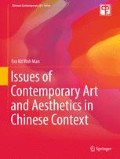Abstract
This chapter starts from the reflection and analysis of the origin of “beauty” in the Confucian aesthetics. It first traces its origin in the suggestion of the Confucian moral mind. The emergence process involved is regarded as a very different one from that of the Western mainstream, in which the subject and object dichotomy is presupposed.
This chapter was originally published in The International Journal of the Humanities, Champaign, Ill., USA: Common Ground Publishing LLC, Vol. 8, Issue 1 (June 2010), 1–12.
Access this chapter
Tax calculation will be finalised at checkout
Purchases are for personal use only
Notes
- 1.
Confucius’ discussion and evaluation of Shao music is recorded in Chap. 3 of Analetics.
- 2.
One of the representative works is Arnold Berleant’s Art and Environment.
- 3.
For further discussion, see Man (2000, pp. 155–169).
References
Battersby, Christine. 1995. Stages on Kant’s way: Aesthetics, morality, and the gendered sublime. In Feminism and tradition in aesthetics, ed. Peg Brand, and Carolyn Korsmeyer. Pennsylvania: Pennsylvania State University Press.
Chan, Wing-tsit, trans. and compiled. 1963. A source book in Chinese philosophy. New York: Princeton University Press.
Eaton, Marcia. 1997. Aesthetics: The mother of ethics. Journal of Aesthetics and Art Criticism 55(4, Fall):355–364.
Felski, Rita. 1995. Why feminism doesn’t need an aesthetic (and why it can’t ignore aesthetics). In Feminism and tradition in aesthetics, ed. Peg Brand, and Carolyn Korsmeyer. Pennsylvania: Pennsylvania State University Press.
French, Marilyn. 1993. Is there a feminist aesthetic? In Aesthetics in feminist perspective, ed. Hilde Hein, and Carolyn Korsmeyer. Bloomington and Indiapolis: Indiana Univeristy Press.
Gablik, Suzi. 1991. The reenchantment of art. New York: Thames and Hudson.
Gould, Timothy. 1995. Intensity and its audiences: Toward a feminist perspective on the kantian sublime. In Feminism and tradition in aesthetics, ed. Peg Brand, and Carolyn Korsmeyer. Pennsylvania: Pennsylvania State University Press.
Hein, Hilde & Korsmeyer, Carolyn. (ed.) 1993. Aesthetics in feminist perspective. Bloomington and Indiapolis: Indiana University Press.
Hein, Hilde. 1993. Refining feminist theory: Lessons from aesthetics. In Aesthetics in feminist perspective, ed. Hilde Hein, and Carolyn Korsmeyer. Bloomington and Indiapolis: Indiana Univeristy Press.
Hein, Hilde. 1995. The role of feminist aesthetics in feminist theory. In Feminism and tradition in aesthetics, ed. Peg Brand, and Carolyn Korsmeyer. Pennsylvania: Pennsylvania State University Press.
Irigaray, Luce. 1987. Is the subject of science gendered? Trans. Carol Mastrangelo Bove. Hypatia, 2(3):65–87.
Kant, Immauel. 1987. Critique of judgment. Trans. Werner S. Pluhar. Indianapolis: Hackett.
Kneller, Jane. 1993. Discipline and silence. In Aesthetics in feminist perspectives, ed. Hilde Hein and Carolyn Korsmeyer. Bloomington and Indiapolis: Indiana University Press.
Langer, C. L. 1988. Against the grain: A working gynergenic art critcism. In Feminist art criticism, eds. Raven, Langer and Frueh. Ann Arbor: UMI Research Press.
Man, Eva K W. 2000. Contemporary feminist body theories and mencius’s ideas of body and mind. Journal of Chinese Philosophy 27(2):155–169. Oxford: Blackwell.
Margolis, Joseph. 1986. Pragmatism without foundations. New York: Basil Blackwell.
Mou, Zongsan. 1974. Intellectual intuition and chinese philosophy. Taipei: Commercial Press.
Tang, Junyi. 1987. Spiritual values of chinese culture. Taipei: Ching Chung Book Stores.
Wolf, Christa. 1985. A letter. In Feminist aesthetics, ed. Gisela Ecker. Boston: Beacon Press.
Zhou, Jinghao. 2003. Remaking China’s public philosophy for the twenty-first century. Portsmouth: Praeger Publishers.
Author information
Authors and Affiliations
Corresponding author
Rights and permissions
Copyright information
© 2015 Springer-Verlag Berlin Heidelberg
About this chapter
Cite this chapter
Man, E.K.W. (2015). Some Reflections on Confucian Aesthetics and Its Feminist Modalities. In: Issues of Contemporary Art and Aesthetics in Chinese Context. Chinese Contemporary Art Series. Springer, Berlin, Heidelberg. https://doi.org/10.1007/978-3-662-46510-3_5
Download citation
DOI: https://doi.org/10.1007/978-3-662-46510-3_5
Published:
Publisher Name: Springer, Berlin, Heidelberg
Print ISBN: 978-3-662-46509-7
Online ISBN: 978-3-662-46510-3
eBook Packages: Humanities, Social Sciences and LawPhilosophy and Religion (R0)

